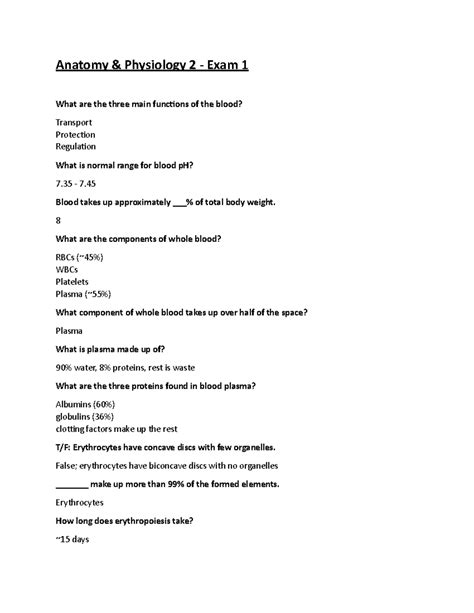Master the Key Concepts for Success

Anatomy and Physiology 2 Exam 1 is a foundational milestone in your medical or healthcare journey. This comprehensive guide equips you with essential strategies to excel in this crucial exam.
Examination Overview
Exam Format: Multiple-choice, true/false, short answer, and essay questions
Exam Duration: Typically 90-120 minutes
Exam Coverage:
- Cardiovascular system
- Respiratory system
- Digestive system
- Urinary system
- Endocrine system
- Reproductive system
Key Concepts to Focus On
Cardiovascular System
- Anatomy of the heart
- Blood flow and circulation
- Blood vessels: structure and function
- Blood pressure and arterial elasticity
Respiratory System
- Anatomy of the lungs and respiratory tract
- Gas exchange and pulmonary ventilation
- Respiratory control and regulation
- Respiratory disorders
Digestive System
- Anatomy of the gastrointestinal tract
- Secretion, digestion, and absorption of nutrients
- Liver and pancreas function
- Gastrointestinal disorders
Urinary System
- Anatomy of the kidneys and urinary tract
- Urine production and excretion
- Renal regulation and hormone control
- Urinary disorders
Endocrine System
- Structure and function of endocrine glands
- Hormone release and regulation
- Hormonal control of metabolism, growth, and reproduction
Reproductive System
- Anatomy of the male and female reproductive systems
- Gamete production and fertilization
- Hormonal regulation of reproductive cycles
- Reproductive disorders
Exam Preparation Strategies
1. Study Effectively
- Use textbooks, lecture notes, and online resources.
- Focus on understanding concepts rather than memorization.
- Practice solving sample questions and exam simulations.
2. Review Regularly
- Space out your study sessions to enhance retention.
- Utilize active recall techniques such as flashcards and quizzes.
- Join study groups or work with a tutor for clarification.
3. Manage Your Time
- Allocate sufficient time for preparation based on the exam’s coverage.
- Prioritize studying topics you find challenging.
- Break down large concepts into smaller, manageable chunks.
4. Seek Professional Help
- Attend office hours with professors or teaching assistants.
- Consult with a tutor or study skills counselor for additional support.
5. Get Ample Rest
- Ensure you get enough sleep before the exam.
- Manage stress through relaxation techniques such as meditation or yoga.
Exam Day Tips
1. Arrive on Time
- Allow ample time to settle in and prepare your materials.
2. Read Instructions Carefully
- Understand the question types and time allocation.
3. Answer Confidently
- Eliminate incorrect answers and make educated guesses.
4. Manage Your Time Wisely
- Allocate time based on question difficulty and points awarded.
5. Don’t Hesitate to Ask for Help
- If you encounter an ambiguous question, seek clarification from the proctor.
Conclusion
By following these comprehensive strategies, you can effectively prepare for Anatomy and Physiology 2 Exam 1. Remember to prioritize understanding, manage your time, and stay confident throughout your preparation and exam day. With consistent effort and dedication, you can achieve your desired exam score and lay a solid foundation for your healthcare career.
Table 1: Tips for Exceling in Anatomy and Physiology 2 Exam 1
| Tip | Benefit |
|---|---|
| Use visual aids (diagrams, animations) | Enhances comprehension and retention |
| Create concept maps and study guides | Organizes information and improves recall |
| Practice solving case studies and clinical scenarios | Applies knowledge to real-world situations |
| Engage in discussions and group work | Clarifies concepts through collaboration |
| Utilize flashcards and apps for quick review | Facilitates active recall and on-the-go studying |
Table 2: Pros and Cons of Different Exam Preparation Methods
| Method | Pros | Cons |
|---|---|---|
| Textbooks | In-depth and comprehensive | Can be dense and overwhelming |
| Lecture notes | Summarized and organized | May be incomplete or lack context |
| Online resources | Interactive and accessible | Can be unreliable or fragmented |
| Study groups | Collaborative and supportive | May be difficult to find compatible groups |
| Tutors | Personalized and tailored guidance | Can be expensive |
Table 3: Frequently Asked Questions
1. How much time should I allocate for exam preparation?
- Typically 20-30 hours depending on your knowledge and comfort level in the subject.
2. What is the key to effective studying?
- Focus on understanding rather than memorization, and practice retrieving information through active recall.
3. Should I memorize every detail from my notes?
- Prioritize understanding key concepts and their interrelationships. Memorization should be used to supplement comprehension.
4. What strategies can help me manage exam anxiety?
- Get enough rest, practice relaxation techniques, and positive self-talk.
5. How can I improve my test-taking skills?
- Practice sample questions, learn time management techniques, and identify question patterns.
6. Is it okay to make educated guesses?
- Yes, eliminate incorrect answers and make logical guesses to increase your chances of getting the right answer.
Table 4: Creative Application of Anatomy and Physiology 2 Concepts
| Concept | Innovative Application |
|---|---|
| Respiratory System | Designing new breathing apparatuses for use in high-altitude or polluted environments |
| Cardiovascular System | Developing cardiovascular monitoring devices that accurately predict heart failure risk |
| Endocrine System | Creating hormonal therapies for treating endocrine disorders and maintaining hormonal balance |
| Digestive System | Engineering gastrointestinal implants for enhancing digestion and nutrient absorption |
| Urinary System | Developing artificial kidney devices for patients with chronic kidney failure |
